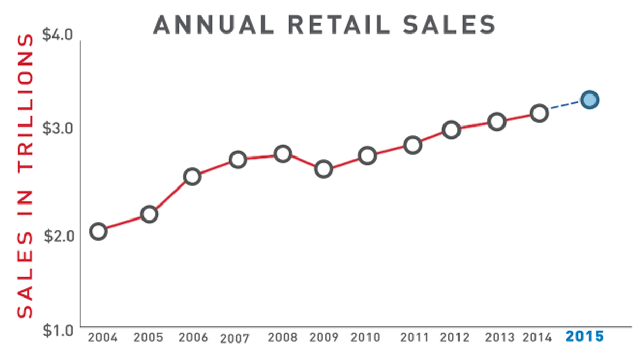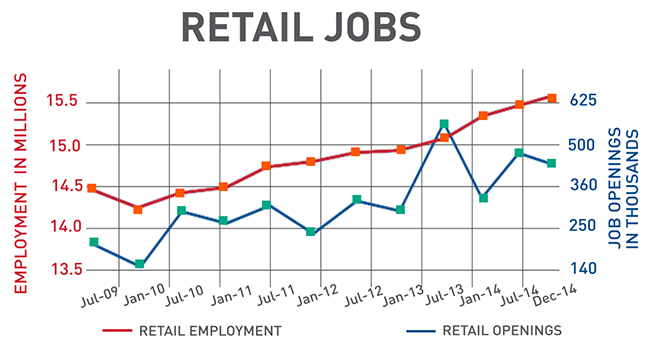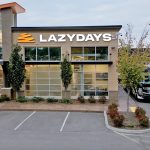The National Retail Federation said it expects retail industry sales, excluding automobiles, gas stations and
restaurants, to grow approximately 4.1 percent in 2015, with online and other
non-store sales expected to increase between 7 and 10 percent in 2015.
In a statement, NRF noted that over the last several quarters, economic activity has been quite volatile, but progress is being made; GDP fell to a negative 2.1 percent in the first quarter of 2014, increased to 4.6 percent in the second quarter, had an impressive growth spurt of 5 percent during the third quarter, but slowed markedly to 2.6 percent in the final three months of the year. And, the economy in 2014 grew by 2.4 percent, better than the Federal Reserve projections for the year. NRF expects the economy in 2015 will grow between 2.7 to 3.2 percent.

On the positive side, a stronger pace of job creation in 2014 set the stage for further job growth and gains in wages. During the year, 2.95 million net new jobs were added, the most since 1999. Given the expectation for economic growth, the NRF expects payrolls to grow in the range of 220,000 to 230,000 jobs per month.
Retail employment and job openings 2009-2014

LOOKING AHEAD: ARE WE THERE YET?
The following are comments from NRF'S Chief Economist Jack Kleinhenz:
When reviewing 2014’s results and looking ahead to 2015, almost immediately I thought out loud, “Are we there yet?!” Much like children during family road trips who cannot wait to get out of the car, economists are asking the same thing of the U.S. economy – are we there yet? Unfortunately, the answer isn’t simple. While the composition of growth accelerated and was broad-based in 2014 and expectations for 2015 remain positive, we still have a ways to go to achieve full economic potential.
Progress is in fact being made to achieve full employment, and economic slack has declined quickly. As such, it is important to recognize that the economy is in transition, moving away from the support and expansionary measures put in place at the time of the recession and toward a new stage of self-dependency and sustainability.
This is uncharted territory for both businesses and consumers alike. The Federal Reserve has ended its quantitative easing, the drag from federal fiscal policy is diminishing and state and local spending is picking up as their economies are benefiting from improved labor and housing markets. Household and business balance sheets have advanced along with easier credit conditions, and Fed chair Janet Yellen said the slack in the economy is no longer “obvious and substantial” and that policy accommodation was no longer “unambiguous.”
I think it is important to also state that as discussions focus on the timing of interest rate increases, no one is out to kill the economy by doing so.
Business spending is expected to grow in 2015, but at a slower pace than in 2014. Since 2010 we have only seen a decline in growth once. The costs of capital and credit conditions are very favorable but firms have been hesitant to invest, and many companies have aging equipment they have held off replacing. However, growth in the economy comes from the underlying forces of increased output, not just consumer spending and increases in wages.
These forces include investments in capital, skills and education, and technology. From this perspective we still have more transitions to make and miles to go. The growth of business spending is limited in part because of uncertainties with domestic economic policy; businesses need to be encouraged to expand and begin the virtuous cycle whereby job growth generates income, which generates spending and reinforces businesses’ desire to expand.
I believe a few factors will continue to support consumers’ strong spending habits through 2015:
- Household spending had its best year since 2006 and is on track to continue to drive the economy forward in 2015.
- Consumers are in better shape now than any time since the start of the recovery and confidence is accelerating.
- Incomes are increasing with job and wage gains.
- Gains in equities and housing have boosted net worth to record levels.
- Energy costs have plummeted.
Consumer spending
Consumer optimism is currently at its highest level since 2004 as Americans are more optimistic about current and future conditions. While concerns surfaced toward the end of 2014 – the beginning of the holiday season – consumers did not disappoint and spending remained strong throughout the final quarter of 2014.
Energy prices
Plummeting energy prices and lower import costs are certainly a tailwind for the economy. It will provide a boost to consumers and businesses who count fuel costs as a key part of their expenses. Unfortunately, the lower oil prices are hitting the energy exploration, development and production sector of the economy, which ironically has been the fastest-growing industry for some time now. Consequently, this has put a drag on investment.
Inflation
With the recent appreciation of the U.S. dollar, core inflation is likely to be restrained for some time. We expect core inflation to move upward over time toward the Fed’s 2 percent target as economic activity picks up and the labor market continues to tighten. Undoubtedly, inflation trends will play an important and growing role in monetary policy decisions. With inflation currently running at 50 percent – the Fed target – the Federal Open Market Committee will enjoy a long runway in normalizing short term interest rates and is unlikely to raise its short-term rates before the second half of 2015.
Global economy
Of course there are uncertainties and risks to this outlook. The biggest concern is the global economy. Recent developments in major economies – such as the last quarter’s decline in Japan’s GDP and weaker growth in the Eurozone and China – pose downside risks. However, these countries could surprise on the upside if monetary policy stimulus staves off the backsliding in growth. If that occurs, it would keep downward pressure on Treasury bond yields. While we don’t anticipate the “lift-off” in U.S. interest rates to become a headwind facing U.S. growth, it could generate volatility in the financial markets. This is uncharted territory for the Fed and poses significant uncertainty surrounding the magnitude of the reaction to higher rates.
IN A NUTSHELL
Economic growth is expected to be above its recent post-recession trend. The baseline outlook calls for growth in the economy (as measured by real GDP) to land between 2.7 and 3.2 percent, a marked improvement over the past several years.
The labor market is expected to improve, averaging 220,000 to 230,000 additional jobs per month, slightly lower than the pace of 245,000 per month in 2014.
Unemployment should drop to 5 percent by year-end.
Inflation as measured by the Consumer Price Index could reach 1.5 percent.
The stronger labor market will boost confidence and stimulate housing demand.
Energy prices will be a wildcard in 2015.
One of the biggest concerns right now is the global economy, though fundamental forces present in the domestic economy should offset the drag from abroad.
We will be keeping a close eye on these and other indicators as the year progresses. If conditions change, our forecast will adjust accordingly.















